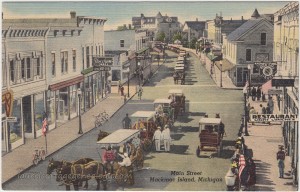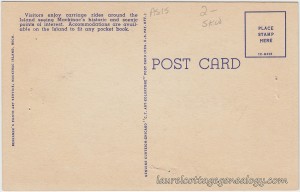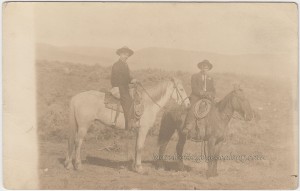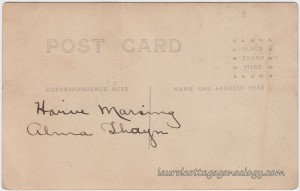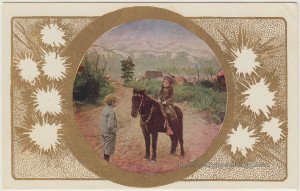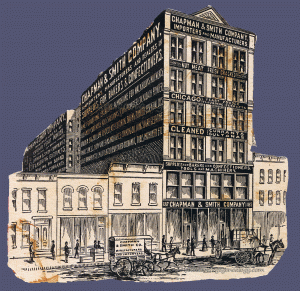“Visitors enjoy carriage rides around the Island seeing Mackinac’s historic and scenic points of interest. Accommodations are available on the Island to fit any pocket book.”
This vintage postcard is estimated to be from the 1950s and was published by Curteich and printed from a photo by Benjamin’s Photo Art Service of Mackinac Island. Robert E. Benjamin was a photographer hired in 1946 by G. W. Wickman, who had started a souvenir photo and postcard shop around 1900 on the Island, having developed his own line of postcards. This is information from the Benjamin of Mackinac website, and they are thankfully still going strong; their store Benjamin Photo and Gift Shop is located on Main St. between the ferry lines. See their site for a full history.
Besides the publisher and photographer info, we’re always looking at any shops with names displayed on these cards such as Florsheim Shoes and the Palm Cafe prominently showing here. The Palm was owned by the Horn Family and later became Horn’s Gaslight Bar & Restaurant, another that is still thankfully in business today. I say thankfully, as in researching these antique and vintage cards and photos we normally find the businesses no longer around. I don’t know about the restaurant advertising “Light Lunches” but find this sign charming. A light lunch would be helpful, after having sampled lots of the famous Mackinac fudge.
Having grown up in Michigan, I got to visit Mackinac (in the 1960s) with the family. We did the bike rental thing around the island and my memory of that is that at the end of the ride there was a steep hill that everyone was gleefully, I guess, riding down. I was the scaredy cat of the group (I was only about five) and refused. Someone must have taken the bike down for me, but I don’t remember. If anyone else has similar memories of this hill, I’d love to hear them. Was the hill really that steep, or was I just unnaturally afraid of hills at that time? Later on, in my early twenties, I lived and worked on Mackinac for part of a summer, and it was pretty wild. You take a bunch of kids just out of high school or still in college, or fugitives from early lost love affairs, blowing off steam in the ’70s at the start of the summertime. But besides all the drinking and partying, a Toga party even, I remember us all thrilling to the sunsets, and seeing the Northern Lights one night, and a moonlight ride around the island. I wish I’d known back then of my family’s ties to the Straights of Mackinac area through our Ojibwe ancestors, and not by a long shot least, I wish I’d stuck around on the Island to continue those friendships that had gotten started. But just to end this one on a kind of funny note, I remember one day my roommate up there came back from exploring some of the unused rooms in our hotel (I think), with some memorabilia from the movie Somewhere In Time that had been shot there, and a nice ladies razor for me, along with a ton of replacement blades. These razors and replacements had been sitting forgotten about in drawers for some years in the hotel. (And they really were not ours to take, but we were young and they seemed abandoned I guess. I’m not saying it was right, though.) But, I just remember thinking, “Wow, I will never ever have to buy razors again!” Well, this was not the case, but they did last for about fifteen years.
Divided back, unused postcard. Circa 1950s. From photo by Benjamin’s Photo Art Service, Mackinac Island, Michigan. Publisher info: Genuine Curteich-Chicago “C.T. Art-Colortone” Post Card (Reg. U.S. Pat. Off.)
Price: $6.00

